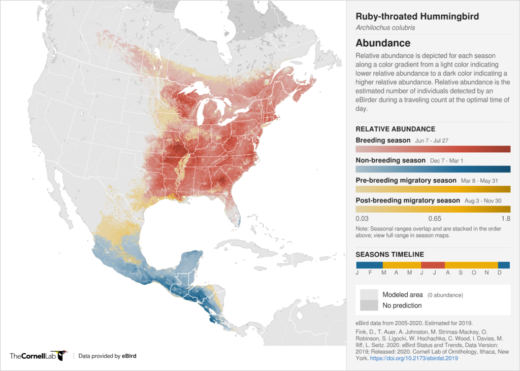eBird is an incredible resource that changes the game of birdwatching for novices and avids. It’s useful for keeping track of your lists, actively participating in conservation efforts, and taking your birding to the next level by using it for atlasing.
If you haven’t used eBird yet, we we want to point you to what eBird says about itself: it “began with a simple idea—that every birdwatcher has unique knowledge and experience.” Good news is, that means eBird was essentially designed for you.
They also say their goal is to gather this information and put it to meaningful use. Each individual sighting even makes maps like this migration pattern of Ruby-throated Hummingbirds possible. Yes, each of those tiny specs of color was once an eBird submission!

Perhaps this sounds nice, and maybe you really want to participate as an atlaser, but maybe you have hesitations. Most people that are unsure about trying eBird get hung up by one of two things:
If either of these are you, eBird actually has you in mind.
As mentioned, eBird was crafted for all experience levels. So the app is actually designed to help less experience birders come to accurate identifications.
When you go to enter a sighting, eBird provides suggestions of common birds in the area. Then, submitted sightings are reviewed by experts that filter out sightings that look incorrect.
So not only will eBird help you come to solid identifications, but there’s also no pressure if you’re sightings aren’t perfect. And if in doubt, just submit what you do know rather than making a guess.
Now what about not wanting to be interrupted while bird watching? Time in the outdoors might be the time you don’t want your phone on you. ebird has you covered too. You can simply scribe your sightings while birding and submit them to eBird later.
This means if you’re already a list taker but you use say a notebook or another resource to save your list, you can still contribute to eBird. And if you’re a list taker, we bet you’re stellar at identification and probably have lots of valuable sightings!
This is the point we really want to emphasize. Your observations are all pieces of data that contribute to us understanding more about birds so we can do things like track their population changes and lessen human impact.
A study came out in 2019 that revealed that we’ve lost almost 3 billion birds since 1970. In other words, there are 3 billion fewer birds on the continent today than in 1970. And lots of this decline is connected to human impact. The more we learn today, the more we can get ahead of issues birds may face tomorrow and even prevent extinction of certain species we know and love. (learn more at 3BillionBirds.org.)
We hope you feel that eBird is nothing to be intimidated by or uneasy about. There are certainly ways you can use it regardless of your skill level, because eBird is made for every bird enthusiast. Make it work for you!
So, are you interested? Maybe still not sure? Then you should check out the eBird Essentials course. It takes less than an hour, and it will walk you through every corner of eBird. Plus it’s free! So go ahead and download eBird or check it out on your desktop or cell phone today. It’s free, user friendly, and we think you’re absolutely gonna love it.
If you already love eBird and are comfortable using it and coming to confident identifications, perhaps you want to take your experience to the next level. Or maybe you want to apply your skills to something great, like a citizen science project.
If this is you, you are a great candidate to become an atlaser in the NC Bird Atlas! Learn more about what this means and how to sign up at ncbirdatlas.org.